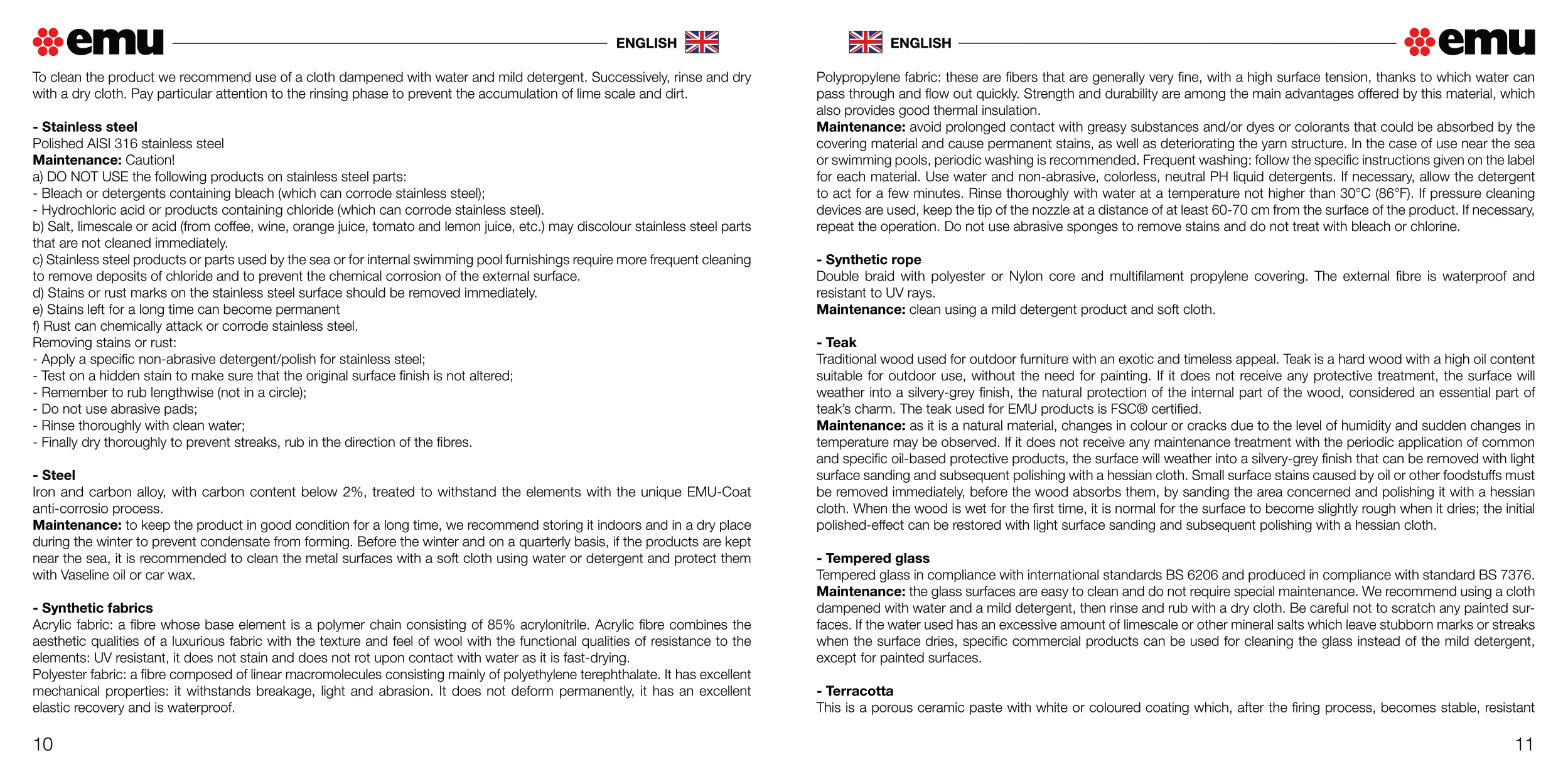10
11
To clean the product we recommend use of a cloth dampened with water and mild detergent. Successively, rinse and dry
with a dry cloth. Pay particular attention to the rinsing phase to prevent the accumulation of lime scale and dirt.
- Stainless steel
Polished AISI 316 stainless steel
Maintenance: Caution!
a) DO NOT USE the following products on stainless steel parts:
- Bleach or detergents containing bleach (which can corrode stainless steel);
- Hydrochloric acid or products containing chloride (which can corrode stainless steel).
b) Salt, limescale or acid (from coffee, wine, orange juice, tomato and lemon juice, etc.) may discolour stainless steel parts
that are not cleaned immediately.
c) Stainless steel products or parts used by the sea or for internal swimming pool furnishings require more frequent cleaning
to remove deposits of chloride and to prevent the chemical corrosion of the external surface.
d) Stains or rust marks on the stainless steel surface should be removed immediately.
e) Stains left for a long time can become permanent
f) Rust can chemically attack or corrode stainless steel.
Removing stains or rust:
- Apply a specific non-abrasive detergent/polish for stainless steel;
- Test on a hidden stain to make sure that the original surface finish is not altered;
- Remember to rub lengthwise (not in a circle);
- Do not use abrasive pads;
- Rinse thoroughly with clean water;
- Finally dry thoroughly to prevent streaks, rub in the direction of the fibres.
- Steel
Iron and carbon alloy, with carbon content below 2%, treated to withstand the elements with the unique EMU-Coat
anti-corrosio process.
Maintenance: to keep the product in good condition for a long time, we recommend storing it indoors and in a dry place
during the winter to prevent condensate from forming. Before the winter and on a quarterly basis, if the products are kept
near the sea, it is recommended to clean the metal surfaces with a soft cloth using water or detergent and protect them
with Vaseline oil or car wax.
- Synthetic fabrics
Acrylic fabric: a fibre whose base element is a polymer chain consisting of 85% acrylonitrile. Acrylic fibre combines the
aesthetic qualities of a luxurious fabric with the texture and feel of wool with the functional qualities of resistance to the
elements: UV resistant, it does not stain and does not rot upon contact with water as it is fast-drying.
Polyester fabric: a fibre composed of linear macromolecules consisting mainly of polyethylene terephthalate. It has excellent
mechanical properties: it withstands breakage, light and abrasion. It does not deform permanently, it has an excellent
elastic recovery and is waterproof.
Polypropylene fabric: these are fibers that are generally very fine, with a high surface tension, thanks to which water can
pass through and flow out quickly. Strength and durability are among the main advantages offered by this material, which
also provides good thermal insulation.
Maintenance: avoid prolonged contact with greasy substances and/or dyes or colorants that could be absorbed by the
covering material and cause permanent stains, as well as deteriorating the yarn structure. In the case of use near the sea
or swimming pools, periodic washing is recommended. Frequent washing: follow the specific instructions given on the label
for each material. Use water and non-abrasive, colorless, neutral PH liquid detergents. If necessary, allow the detergent
to act for a few minutes. Rinse thoroughly with water at a temperature not higher than 30°C (86°F). If pressure cleaning
devices are used, keep the tip of the nozzle at a distance of at least 60-70 cm from the surface of the product. If necessary,
repeat the operation. Do not use abrasive sponges to remove stains and do not treat with bleach or chlorine.
- Synthetic rope
Double braid with polyester or Nylon core and multifilament propylene covering. The external fibre is waterproof and
resistant to UV rays.
Maintenance: clean using a mild detergent product and soft cloth.
- Teak
Traditional wood used for outdoor furniture with an exotic and timeless appeal. Teak is a hard wood with a high oil content
suitable for outdoor use, without the need for painting. If it does not receive any protective treatment, the surface will
weather into a silvery-grey finish, the natural protection of the internal part of the wood, considered an essential part of
teak’s charm. The teak used for EMU products is FSC® certified.
Maintenance: as it is a natural material, changes in colour or cracks due to the level of humidity and sudden changes in
temperature may be observed. If it does not receive any maintenance treatment with the periodic application of common
and specific oil-based protective products, the surface will weather into a silvery-grey finish that can be removed with light
surface sanding and subsequent polishing with a hessian cloth. Small surface stains caused by oil or other foodstuffs must
be removed immediately, before the wood absorbs them, by sanding the area concerned and polishing it with a hessian
cloth. When the wood is wet for the first time, it is normal for the surface to become slightly rough when it dries; the initial
polished-effect can be restored with light surface sanding and subsequent polishing with a hessian cloth.
- Tempered glass
Tempered glass in compliance with international standards BS 6206 and produced in compliance with standard BS 7376.
Maintenance: the glass surfaces are easy to clean and do not require special maintenance. We recommend using a cloth
dampened with water and a mild detergent, then rinse and rub with a dry cloth. Be careful not to scratch any painted sur-
faces. If the water used has an excessive amount of limescale or other mineral salts which leave stubborn marks or streaks
when the surface dries, specific commercial products can be used for cleaning the glass instead of the mild detergent,
except for painted surfaces.
- Terracotta
This is a porous ceramic paste with white or coloured coating which, after the firing process, becomes stable, resistant
ENGLISH
ENGLISH


